Phongsavan — Milwaukee's Hmong Marketplace (with Food Court)
Phongsavan — Milwaukee's Hmong Marketplace (with Food Court)
-
-
-
-
-
Phongsavan — Milwaukee's Hmong Marketplace (with Food Court)
-
Post #1 - May 7th, 2013, 10:46 amPhongsavan, the Hmong market in Milwaukee, is well worth a visit. It's tiny compared to its Saint Paul counterparts but there's nothing quite like it in Chicago. The building, a converted auto parts store immediately south of the CVS store on 76th, has no formal sign except for several small placards advertising Hmong businesses.

The front entrance is the yellow door closest to CVS. For the food-related businesses, keep heading toward the back of the building, past the small stalls selling videos, clothing and cosmetics until you reach the bright, high-ceilinged food area.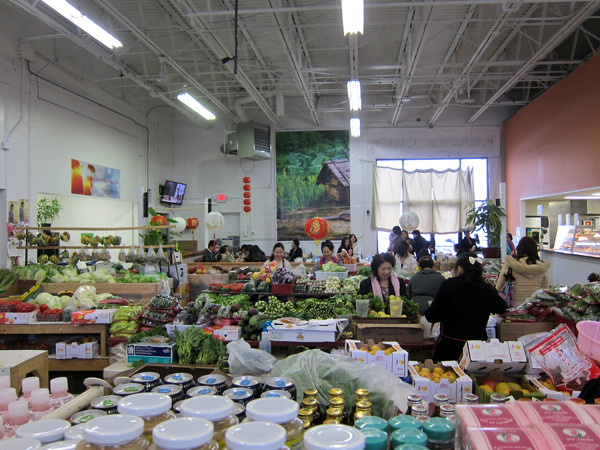
The northern third of this room is devoted to packaged foods, the middle to fresh produce, and the other end to prepared food. Sister's Café, at one side of the seating area, sells mostly cold items.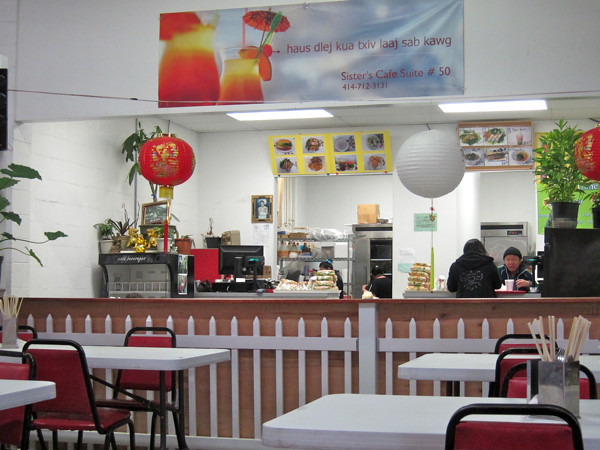
Some are usual SE Asian snacks such as banh mi, papaya salad, spring rolls and leaf-wrapped sticky rice.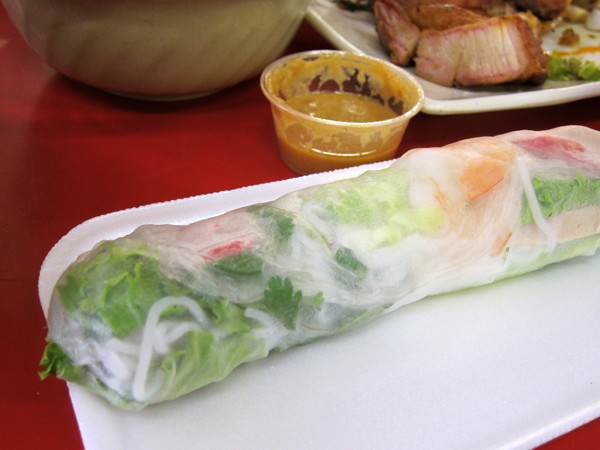
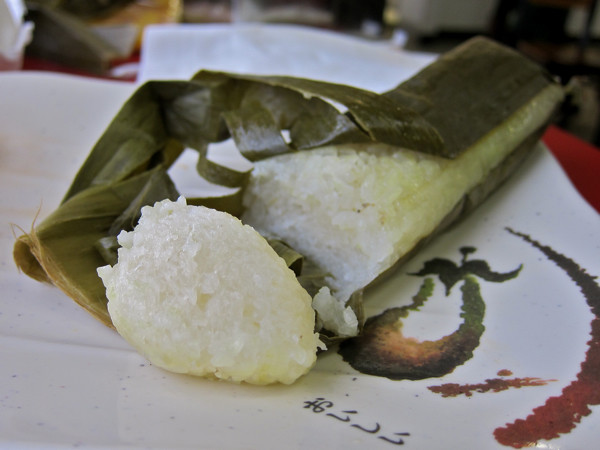
Sister's also sells some specifically Hmong items such as a sweet and sticky steamed cornbread (ncuav pob kws*).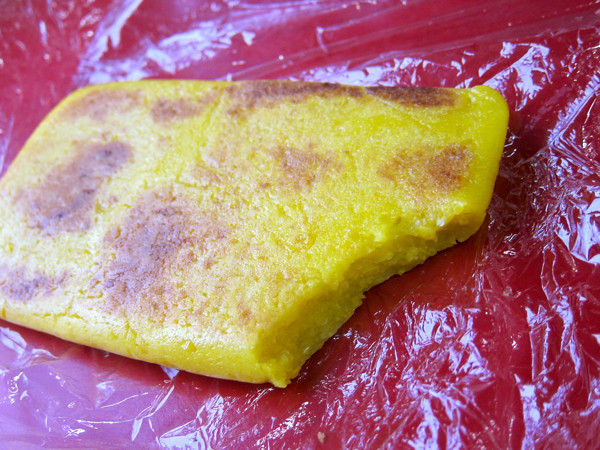
One of the more interesting offerings is seasoned steamed eggs.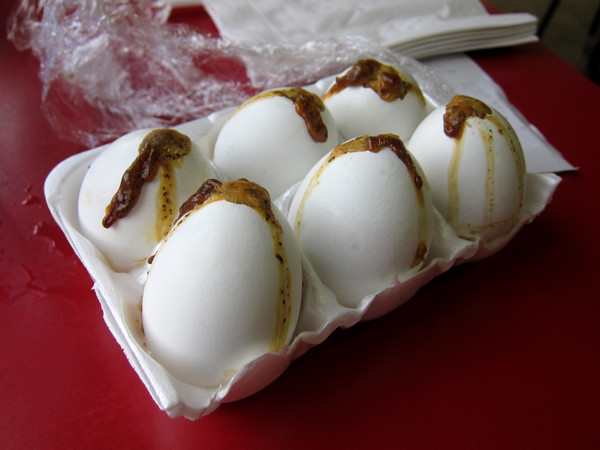

Tahauj cub xyaw qe are made by extracting the insides of raw eggs, adding seasonings such as fish sauce and black pepper, and squirting the mixture back into the intact shells.
On the other side of the dining area is a restaurant serving hot foods from a steam table and hot box.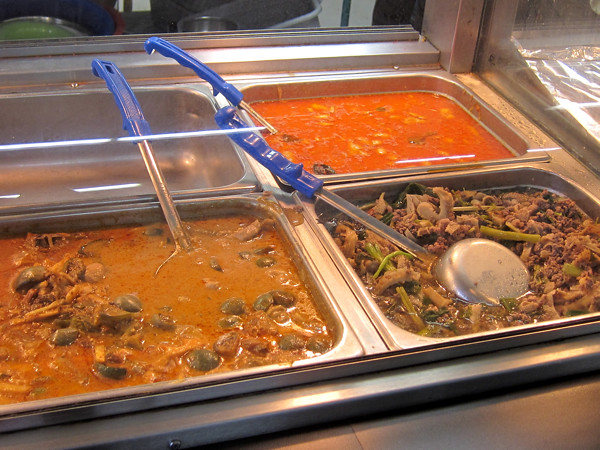
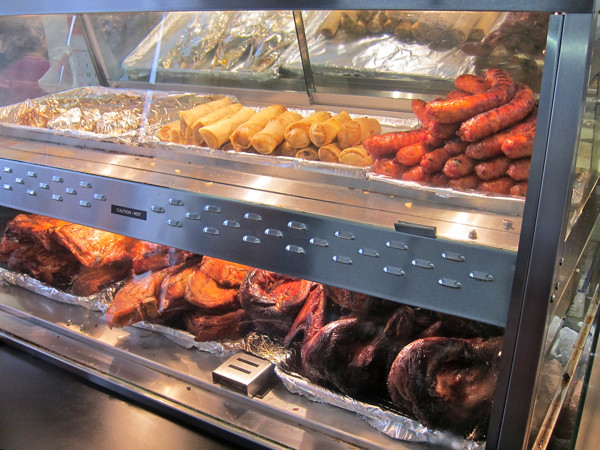
Top of hot box: steamed whole fish, egg rolls, sausage. Bottom: two types of roast pork, whole ducks. The selection varies from day to day and hour to hour but it's a good bet there will be Hmong-style sausages (nyhuv ntxwm hmoob). These coarse textured beauties don't have the fermented flavor of some Thai sausages but they're really tasty with the hot and sour (very!) dipping sauce.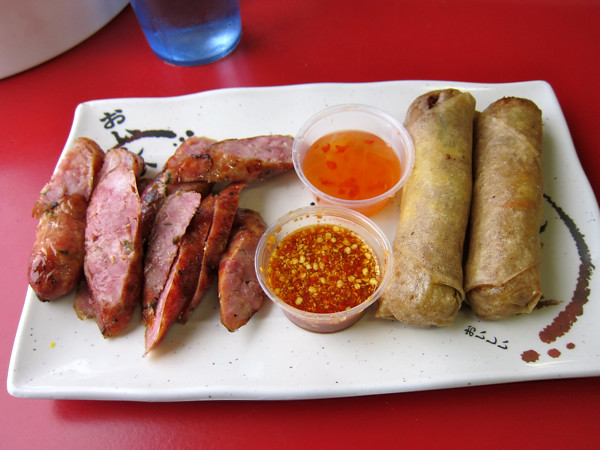
Eggrolls (kab yob), filled with glass noodles and ground chicken, are really good. Load up, especially if they're fresh out of the fryer.
Sticky purple rice (txhuv ntsav) is always available, excellent, an essential order. If stuffed chicken wings (kooj tis qaib ntim) are on offer don't pass them up.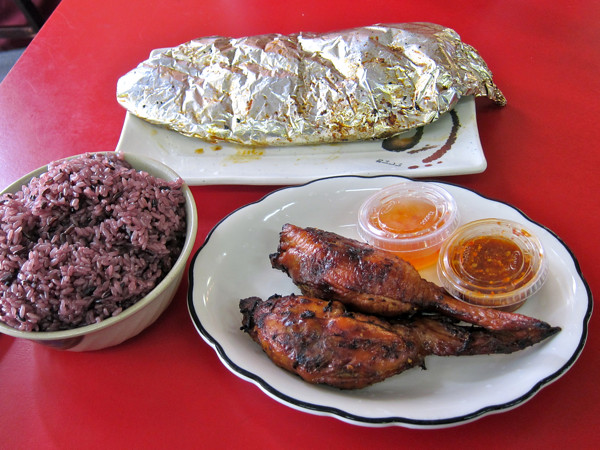
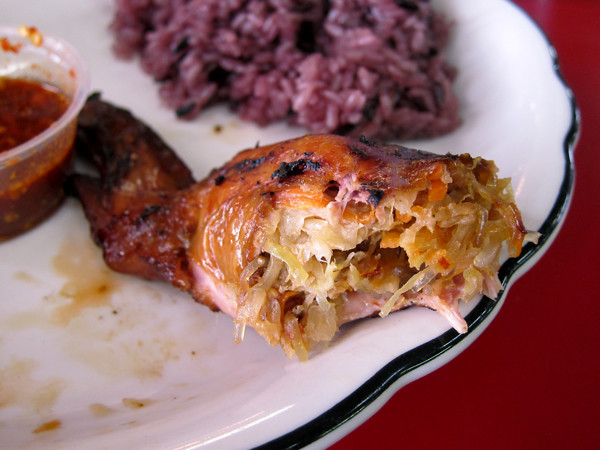
They're stuffed with the same filling as the egg rolls. I can't imagine anyone not liking these. Steamed fish probably wouldn't be as much of a crowd pleaser.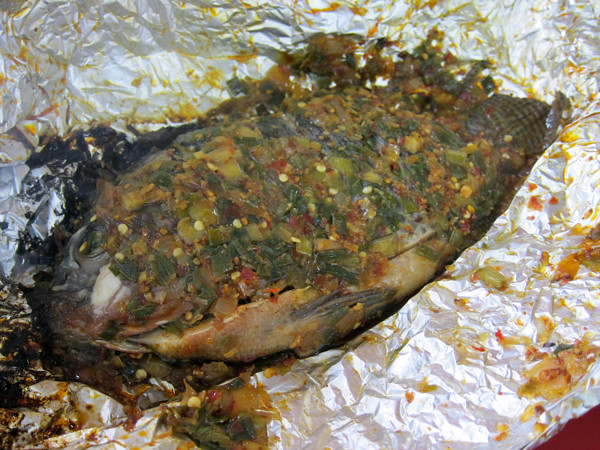
That coating looks complex and delicious but it was surprisingly hot and monotonous. The fish wasn't awful but there's better stuff.
Khaub poob, noodles in coconut-enriched chicken broth is well worth ordering if it's available. Ditto for the chicken and eggplant curry in the background (both are $4 for a generous serving).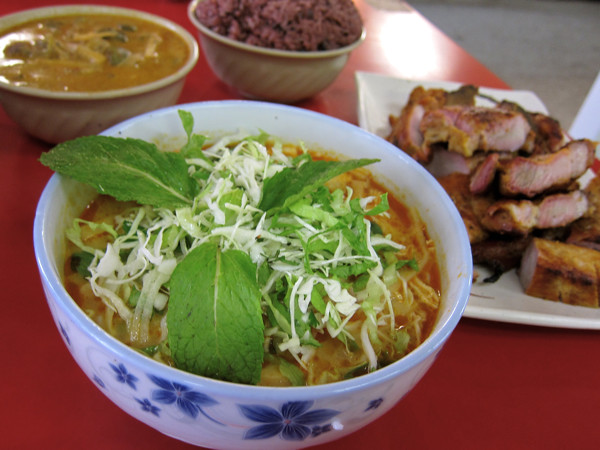
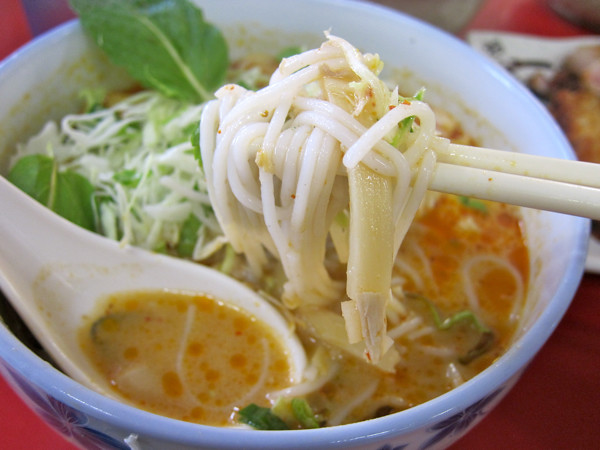
This pork option was decent but not terribly exciting. The pork belly (I think) might be the better choice.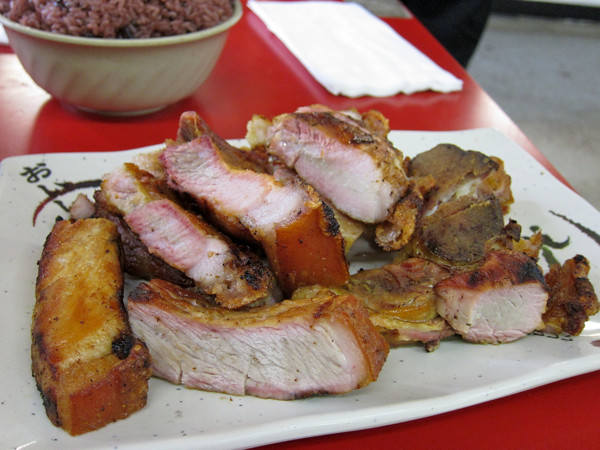
You never know what will turn up. There's a good chance you'll find the classic Hmong bitter offal stew, containing a variety of inner meats seasoned with bile. I think that's it at the front right of the steam table photo above.
For me, the prepared Hmong food is the big draw but the market area is pretty good, though probably not worth a special trip from Chicago.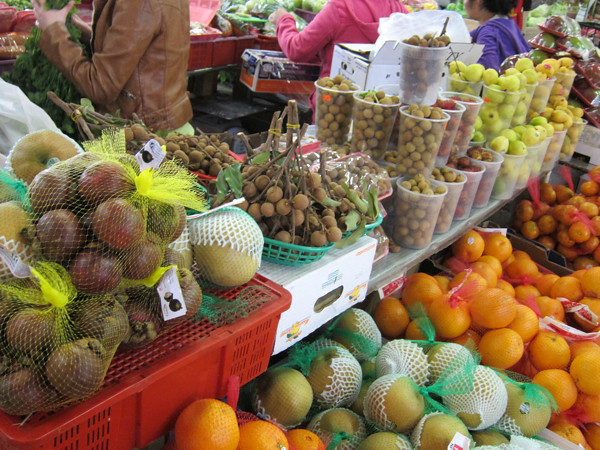
The produce section has some less common items such as mangosteens, longans and baby mangoes.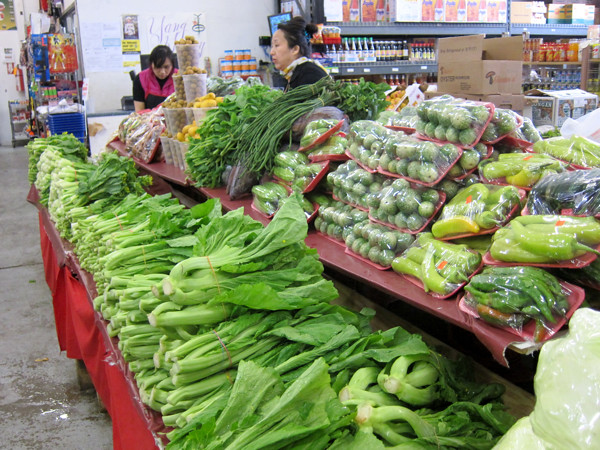
There's always a wide variety of greens, most in very good condition.
Some of the produce is pre-wrapped but when it's as lovingly done as with these mushrooms it's not so annoying. The grocery store in the center of the building is also worth exploring. Much of the stock will be familiar to anyone who frequents the Asian markets of Chicago but there's definitely some different stock, including a good selection of frozen Hmong sausages imported from Saint Paul. Red Boat fish sauce can be bought for a dollar less than on Argyle.
There are plans to significantly expand the facility.
I'm not sure of the current timetable but I don't think it's happening this spring (note that "2013" has been pasted over an earlier year).
If you can't make it to Saint Paul, Phongsavan is a good substitute. Phongsavan has been mentioned here numerous times, though with little detail about the food: 1, 2, 3, 4, 5, 6, 7, 8, 9, 10.
Phongsavan
Milwaukee's Asian Market
6300 N 76th St
Milwaukee WI
* The Hmong language has traditionally been spoken only, but in the 1950s, Western missionaries devised a written Hmong language, the Romanized Popular Alphabet. The fifty-some consonants are rendered by Roman consonants, either singly or in combinations (double, triple, quadruple). The fourteen vowels are indicated by various combinations of a, e, i, o, u and w. In general words are monosyllabic but can be spoken with one of seven tones. The final consonant indicates the tone. This explains a bit about words such as ntxwm (part of the word for sausage): a combination of consonant (ntx) + vowel (w) + tone marker (m, indicating the low-falling tone). A general introduction can be found here and here is a dictionary with useful background.
Edited to restore photo links.Last edited by Rene G on July 18th, 2016, 3:51 pm, edited 2 times in total.
-
-
Post #2 - May 7th, 2013, 10:51 amIlluminating...jaw dropping. I need to get to Milwaukee next time I'm in Chicago, pronto.
Thanks so much for sharing this.
As a side note - wasn't the guy from Arun's planning something similar in Chicago somewhere out on the northwest side?"By the fig, the olive..." Surat Al-Teen, Mecca 95:1"
-
-
Post #3 - May 7th, 2013, 11:47 amWe have discussed this mall before, but without such great pictures. Good Job!
One of the vendors has a great freezer section as well for items not readily available.
As summer approaches, I was told that there will be a local Farmer's Market in the fenced off area next to the mall that is currently used for parking.
While you visit the place, the best Pastrami in Milwaukee is directly across from them at Spartan Gyro.
Also (IMHO) the best corned beef is close at House of Corned beef on Silver Spring. For the model railroad fanatic, Walther's is very close as well. (if you are into Lionel, go to the store in Butler, not that far away - where Walther's sends you if you ask)
I cannot believe that the expansion has already been 95% leased according to my last report.
Also while in that area visit Rhino Foods on Hampton as another Hmong/Jamaican grocery. They also sell hot foods. Where I go to buy my rice.
Pacific Produce is moving close by at 8340 W. Appleton Ave. But despite the large area (60K sq. ft) their reputation follows them. As a fellow LTH forum member told me at a meet-up "The single most health inspection violations in Milwaukee". Thee are printed reports that their other location in Greenfield on 27th was going to be shut down by the town but that they made "changes" and things are still up in the air.
When driving west on Mill, the best bet is to cut through the CVS parking lot to get there. You otherwise will have to do a u-turn at the light in a major intersection.
The shopping mall north of them across the street is known for car break-ins, and there have been several shootings as well. However since the mall is
on the other side of Mill with nothing else there but Remy battery, there have been no known issues that I am aware of by the mall itself. Just a warning to NOT go to that mall, but this one has always been safe.
Going in there is a wonderful experience. Everyone I have ever dealt with there has been very friendly.
(edit) if you are coming up to go here and want suggestions tailored to your trip in the immediate area, please send me a message.
-
-
Post #4 - May 7th, 2013, 3:20 pmI have been to the Hmong markets in St. Paul. I felt out of place, overwhelmed and lost, although the offerings looked intriguing. The Milwaukee version seems like a more intimate and friendly environment where a person could spend time investigating the various products, their uses and preparations; asking a lot of stupid questions without angering the shopkeepers. I wonder if there are any "guides" who are willing to conduct mini-tours of the culinary and cultural highlights of the mall? I am sure there would be more than a few LTH'ers willing to participate. Hmong culture has long interested me, but I know very little about it.
-
-
Post #5 - May 7th, 2013, 3:51 pmTo be honest, right now there is not that much that would require a tour, but there are a couple of vendors of fresh food and the frozen market that are always there to help. The mall is currently only 20K sq ft. Think of a "Western Auto" or "Autozone" where the back part has been opened up as well. A lot of which is selling non-food items. Mitsuawa marketplace in Arlington Heights that took over from the Japanese market that took over the former Klem's Nursery has more floor space.
-
-
Post #6 - May 9th, 2013, 1:52 pmHabibi wrote:I need to get to Milwaukee next time I'm in Chicago
banner quote?
-
-
Post #7 - May 11th, 2013, 5:53 pmHabibi wrote:As a side note - wasn't the guy from Arun's planning something similar in Chicago somewhere out on the northwest side?
Chicago's Thai Town Center project sounds interesting but I suspect it won't have much in common with Phongsavan in Milwaukee. Arun Sampanthavivat and two partners managed to get $1.5 million in Tax Increment Financing to convert a vacated police station into a restaurant, spa and shops. Work is well underway.
Thai Town Center, 4461 N Pulaski, May 2013 exvaxman wrote:I cannot believe that the expansion has already been 95% leased according to my last report.
exvaxman wrote:I cannot believe that the expansion has already been 95% leased according to my last report.
It is surprising that so many people signed leases for a project that has been delayed for so long. Phongsavan's expansion has been discussed as though it was imminent at least as far back as 2010. Hopefully they can pull it off. Do you know when construction will start (or has it already)?d4v3 wrote:I wonder if there are any "guides" who are willing to conduct mini-tours of the culinary and cultural highlights of the mall? I am sure there would be more than a few LTH'ers willing to participate. Hmong culture has long interested me, but I know very little about it.
It might be worth calling to see if someone would be willing to show a group around. I didn't include a phone number in my original post because I had no idea who answers (I now think it's the owner/developer's phone). It would be interesting to find out more about Milwaukee's Hmong community (and the Hmong in general) as well as specifics about what's on offer in the restaurants and shops. Things like: How is the purple rice prepared (not as simple as some may think)? Which dishes are bittered with bile? What's the difference between all those brands of Hmong sausage? How are some of the medicinal herbs used?
But as exvaxman says, a guide isn't necessary. I'll confirm his comment that everyone is very friendly and helpful. It seems to me that English is more commonly spoken there than at the Hmong markets in Saint Paul.
Phongsavan — Milwaukee's Asian Market
6300 N 76th St
Milwaukee WI
414-531-9259 (Pai Yang)
http://milwaukeeasianmarket.com (warning: obnoxious sounds)
-
-
Post #8 - May 11th, 2013, 9:56 pmHere is a link for purple rice: http://hmongcancook.blogspot.com/2010/0 ... -milk.html
They were doing some major repairs, pulling up the concrete floor to get to the (sewer?) pipes the last time I was in. I am assuming that they will be finishing infrastructure repairs before the expansion. They are like Pacific Produce in the (lack of) speed. The announcement was almost two years before the actual opening.
If you want more than Hmong, there is an Indian grocery, a Thai grocery, a butcher that carries German food, and a combined Hmong/Jamacian grocery right near by. Also a honey processor that has a small outlet store as well.
-
-
Post #9 - April 7th, 2014, 4:15 pmRene G wrote:exvaxman wrote:I cannot believe that the expansion has already been 95% leased according to my last report.
It is surprising that so many people signed leases for a project that has been delayed for so long. Phongsavan's expansion has been discussed as though it was imminent at least as far back as 2010. Hopefully they can pull it off. Do you know when construction will start (or has it already)?exvaxman wrote:They were doing some major repairs, pulling up the concrete floor to get to the (sewer?) pipes the last time I was in. I am assuming that they will be finishing infrastructure repairs before the expansion.
At least to my untrained eyes, Phongsavan looks mostly unchanged, although those central doors are now functional.
One of the two businesses that made up the café (on the east side of the food court) has disappeared, and with it, the seasoned hardboiled eggs (see post #1). A pity. The restaurant (on the west side) seems much the same. I finally got a chance to try the pho, obviously a favorite order of many customers.
It's pleasant enough but really nothing special. The broth is somewhat thin and the accompaniments rather meager. You can get much better at many places in Chicago. The kao pong is a better choice in the noodle category.
This bowl had quite a bit more heat than my first, and I think it was better for it. Consider ordering it spicy. In addition to kao pong, I'd recommend the stuffed wings and maybe take a chance on something from the steam table. The produce market continues to impress with freshness and variety (last visit I noticed bac ha—spongy taro stems, not terribly common) and the grocery stores are well worth exploring for Lao sausages etc. It's already a fun stop when in Milwaukee and I have my fingers crossed that someday the expansion will happen.
Phongsavan — Milwaukee's Asian Market
6300 N 76th St
Milwaukee WI
414-760-3771 (grocery)
414-716-5034 (restaurant)
414-716-5035 (café)
http://milwaukeeasianmarket.com (warning: obnoxious sounds)
-
-
Post #10 - June 10th, 2014, 10:27 amMilwaukee Asian market expansion to include nine restaurants, 143 booths...
Milwaukee’s Plan Commission approved the project on Monday.
The roughly 25 retailers in Asian Market Phongsavan’s existing building will move to the new one, said Ben Mohns, president of Mohns Inc., the Waukesha-based general contractor on the project. A grocery that is in the back of the building will expand to occupy the entire space.Cathy2
"You'll be remembered long after you're dead if you make good gravy, mashed potatoes and biscuits." -- Nathalie Dupree
Facebook, Twitter, Greater Midwest Foodways, Road Food 2012: Podcast
-
-
Post #11 - June 10th, 2014, 11:56 amWow -- I need to get to Milwaukee soon."All great change in America begins at the dinner table." Ronald Reagan
http://midwestmaize.wordpress.com
-
-
Post #12 - March 27th, 2015, 2:55 pmAny recent experience here? Thinking of heading to Milwaukee on Sunday. Is this place worth a visit (still)?Think Yiddish, Dress British - Advice of Evil Ronnie to me.
-
-
Post #13 - March 27th, 2015, 3:00 pmHi,
I haven't been there recently, though I think it is always worth visiting.
I have been there early, like 10:00 am, and later, after 4:00 pm. Either end of the cycle, there is food not yet finished cooking or it is sold out. Try to get there for the midday rush where everything is plentiful.
I especially like those gigantic stuffed chicken wings.
Have fun and report back, please!
Regards,Cathy2
"You'll be remembered long after you're dead if you make good gravy, mashed potatoes and biscuits." -- Nathalie Dupree
Facebook, Twitter, Greater Midwest Foodways, Road Food 2012: Podcast
-
-
Post #14 - March 30th, 2015, 5:50 amFunny, I live in SE Wisconsin south of Milwaukee and have completely stopped shopping and dining at any Milwaukee Asian markets or restaurant and now confine my Asian shopping and dining exclusively to Chicago land!
Selection, quality and freshness are all factors in food purchasing and I have found the restaurants in the Milwaukee area not as 'authentic' as I believe when I compare cusines. Often, I find cheaper ingredient substitutions in Milwaukee restaurants. I also believe that the ethnic populations are not as large in the Milwaukee as Chicago area to adequately support the cusine.
So, did you go on Sunday and what did you experience?-Dick
-
-
Post #15 - March 30th, 2015, 2:08 pmbudrichard wrote:Funny, I live in SE Wisconsin south of Milwaukee and have completely stopped shopping and dining at any Milwaukee Asian markets or restaurant and now confine my Asian shopping and dining exclusively to Chicago land!
Selection, quality and freshness are all factors in food purchasing and I have found the restaurants in the Milwaukee area not as 'authentic' as I believe when I compare cusines. Often, I find cheaper ingredient substitutions in Milwaukee restaurants. I also believe that the ethnic populations are not as large in the Milwaukee as Chicago area to adequately support the cusine.
So, did you go on Sunday and what did you experience?-Dick
That may be true on a broad level, but on the other hand, how many Hmong live in the Chicago area?
So, I don't know the answer to that, but I'm not aware of anything in the Chicago area like Phongsavan. Even pre-launch of Market 2.0, this place was very cool, very transportative to another world. I mean it's not totally brimming with stuff, and do you really need to go home with one of those cute outfits? And a lot, I mean a lot of Chinese broccoli was for sale at the expense of nary another vegetable at the produce stand that, like I say, seemed transported straight from Asia.
Prepared foods, again your options are not wide.
There are 2 food stalls. One specializes in ice drinks of the kind with jello swirls and red beans, plus spring rolls, and as pictured above, papaya salad made to order. They were very nervous about how many chili's I could handle. They went with 2, but really it was not enough. Still, really fun stuff, heavy with the brine from like pickled crab or something like that. A murky, funky, not bright, big bowl for $5.
The other stand, had, as ReneG has shown, I guess, noodles, but my eyes and nose really led me to the BBQ meats. They use an upright Chinese style oven, you know something that looks like the solitary confinement box in Cool Hand Luke, but the meats were done in a more luscious, richer style than Chinese BBQ. Better, they're served with a dip intense both of chili and fish sauce. It makes Small's* Tiger Cry sauce look like Chef-Boy-R-Dee in comparison. Choices included pork belly and pork shoulder steaks. The latter was more for crispness, the former for goo. Do like I did. Get one steak, sold by the piece and a portion of belly, sold by the lb. There aint anything like this in Chicago.
I'm also selling the produce area a bit short. Yes, there was plenty of Chinese broccoli, but a few other stuff too. The proprietress was very friendly, offering recipes and ideas in her limited English. The big bunches were Hmong cilantro, better she said, and there were other wrapped bags of herbs and leaves, "for women, soup." Not like we needed much, but we came home with both of those and a package of oyster mushrooms packed with more herbs and a few dried peppers "for soup." I expect when the area farmers are producing, this will be even better.
It's a bit of a schlep away from the rest of Milwaukee, but schlep-worthy for sure.
*Actually had my first mediocre time at Smalls the other day--sides still great but awful brisket. Went to post about it, and was thoroughly surprised on it's non-GNR-ship.Think Yiddish, Dress British - Advice of Evil Ronnie to me.
-
-
Post #16 - March 31st, 2015, 4:00 pmbudrichard wrote:Funny, I live in SE Wisconsin south of Milwaukee and have completely stopped shopping and dining at any Milwaukee Asian markets or restaurant and now confine my Asian shopping and dining exclusively to Chicago land!
Selection, quality and freshness are all factors in food purchasing and I have found the restaurants in the Milwaukee area not as 'authentic' as I believe when I compare cusines. Often, I find cheaper ingredient substitutions in Milwaukee restaurants. I also believe that the ethnic populations are not as large in the Milwaukee as Chicago area to adequately support the cusine.
So, did you go on Sunday and what did you experience?-Dick
If you're interested only in general Asian or SE Asian, there's little question you'll do better in and around Chicago. But where in Chicago do you go for the Hmong experience, to eat some Hmong sausage and sticky purple rice, and hear the unique and beautiful Hmong language being spoken? Phongsavan is only a shadow of what you'll find in St Paul, but it's the best you're going to do around here.Vital Information wrote:Even pre-launch of Market 2.0, this place was very cool, very transportative to another world.
Thanks for the report, and glad to hear you enjoyed your visit. I think it's been about a year since I've been to Phongsavan. Do you know how Market 2.0 is coming along?Vital Information wrote:There are 2 food stalls. One specializes in ice drinks of the kind with jello swirls and red beans, plus spring rolls, and as pictured above, papaya salad made to order. They were very nervous about how many chili's I could handle. They went with 2, but really it was not enough. Still, really fun stuff, heavy with the brine from like pickled crab or something like that. A murky, funky, not bright, big bowl for $5.
It's really a shame the third food stall closed. They served some uniquely Hmong foods, like sticky rice cornbread and seasoned eggs steamed in their shells. You remind me I need to try the papaya salad at Phongsavan. Your words—murky, funky, not bright—perfectly describe some I've enjoyed in the Hmong markets of St Paul. The Hmong style seems quite different from the usual bright and sweet Thai-style som tum you'll most often get in Chicago. Both have their charms.
-
-
Post #17 - July 19th, 2016, 4:50 amFrom Journal Sentinel - Construction on the new 84,000-square-foot retail center was recently completed next door to the older facility, located at 6300 N. 76th St., and the new market is projected to open in a month (July).
-
-
Post #18 - July 19th, 2016, 6:39 am
An LTH field trip perhaps??"Knowledge is knowing a tomato is a fruit; wisdom is not putting it in a fruit salad." Miles Kington
-
-
Post #19 - July 19th, 2016, 8:39 amboudreaulicious wrote:
An LTH field trip perhaps??
Sign me up.Steve Z.
“Only the pure in heart can make a good soup.”
― Ludwig van Beethoven

